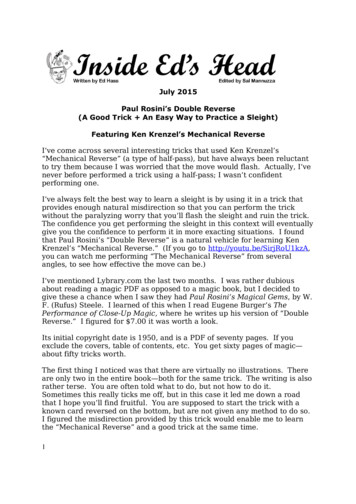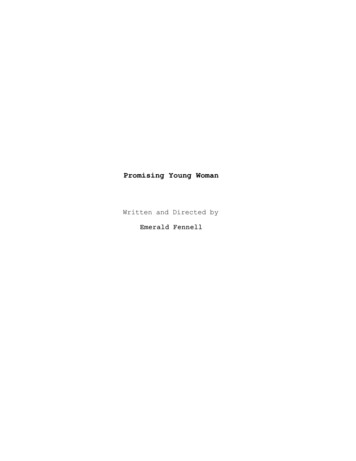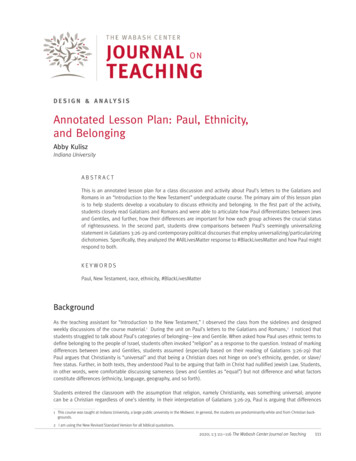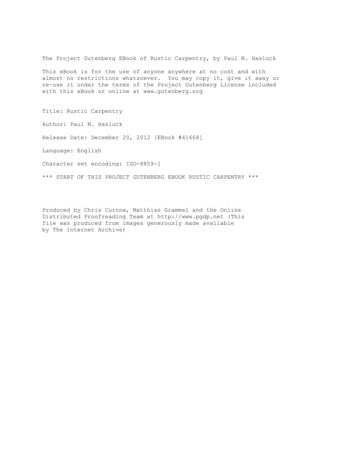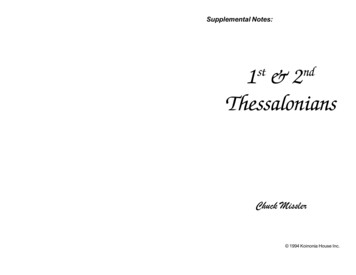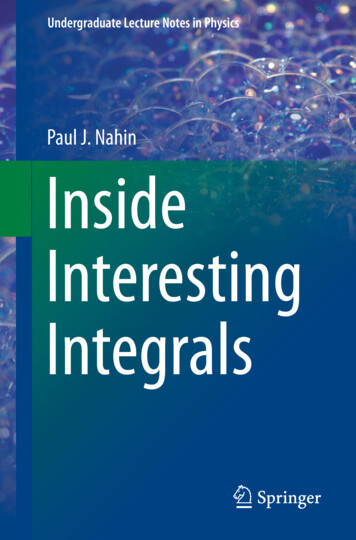
Transcription
Undergraduate Lecture Notes in PhysicsPaul J. NahinInsideInterestingIntegrals
Undergraduate Lecture Notes in PhysicsFor further volumes:http://www.springer.com/series/8917
Undergraduate Lecture Notes in Physics (ULNP) publishes authoritative texts coveringtopics throughout pure and applied physics. Each title in the series is suitable as a basis forundergraduate instruction, typically containing practice problems, worked examples,chapter summaries, and suggestions for further reading.ULNP titles must provide at least one of the following: An exceptionally clear and concise treatment of a standard undergraduate subject. A solid undergraduate-level introduction to a graduate, advanced, or non-standardsubject. A novel perspective or an unusual approach to teaching a subject.ULNP especially encourages new, original, and idiosyncratic approaches to physicsteaching at the undergraduate level.The purpose of ULNP is to provide intriguing, absorbing books that will continue to bethe reader’s preferred reference throughout their academic career.Series EditorsNeil AshbyProfessor Emeritus, University of Colorado, Boulder, CO, USAWilliam BrantleyProfessor, Furman University, Greenville, SC, USAMichael FowlerProfessor, University of Virginia, Charlottesville, VA, USAMichael InglisProfessor, SUNY Suffolk County Community College, Selden, NY, USAHeinz KloseProfessor Emeritus, Humboldt University Berlin, GermanyHelmy SherifProfessor, University of Alberta, Edmonton, AB, Canada
Paul J. NahinInside Interesting Integrals(with an introduction to contour integration)A Collection of Sneaky Tricks, SlySubstitutions, and Numerous OtherStupendously Clever, Awesomely Wicked,and Devilishly Seductive Maneuversfor Computing Nearly 200 PerplexingDefinite Integrals From Physics, Engineering,and Mathematics (Plus 60 ChallengeProblems with Complete, Detailed Solutions)
Paul J. NahinElectrical and Computer EngineeringUniversity of New HampshireDurham, NH, USAISSN 2192-4791ISSN 2192-4805 (electronic)ISBN 978-1-4939-1276-6ISBN 978-1-4939-1277-3 (eBook)DOI 10.1007/978-1-4939-1277-3Springer New York Heidelberg Dordrecht LondonLibrary of Congress Control Number: 2014945223 Springer Science Business Media New York 2015This work is subject to copyright. All rights are reserved by the Publisher, whether the whole or partof the material is concerned, specifically the rights of translation, reprinting, reuse of illustrations,recitation, broadcasting, reproduction on microfilms or in any other physical way, and transmission orinformation storage and retrieval, electronic adaptation, computer software, or by similar or dissimilarmethodology now known or hereafter developed. Exempted from this legal reservation are brief excerptsin connection with reviews or scholarly analysis or material supplied specifically for the purpose of beingentered and executed on a computer system, for exclusive use by the purchaser of the work. Duplicationof this publication or parts thereof is permitted only under the provisions of the Copyright Law of thePublisher’s location, in its current version, and permission for use must always be obtained fromSpringer. Permissions for use may be obtained through RightsLink at the Copyright Clearance Center.Violations are liable to prosecution under the respective Copyright Law.The use of general descriptive names, registered names, trademarks, service marks, etc. in thispublication does not imply, even in the absence of a specific statement, that such names are exemptfrom the relevant protective laws and regulations and therefore free for general use.While the advice and information in this book are believed to be true and accurate at the date ofpublication, neither the authors nor the editors nor the publisher can accept any legal responsibility forany errors or omissions that may be made. The publisher makes no warranty, express or implied, withrespect to the material contained herein.Printed on acid-free paperSpringer is part of Springer Science Business Media (www.springer.com)
Bernhard Riemann (1826–1866), the German mathematical genius whose integral is the subject ofthis book (AIP Emilio Segrè Visual Archives, T. J. J. See Collection)
This book is dedicated to all who, when they read thefollowing line from John le Carré’s 1989 Cold Warspy novel The Russia House, immediately know theyhave encountered a most interesting character:“Even when he didn’t follow what he waslooking at, he could relish a good page ofmathematics all day long.”as well as to all who understand how frustrating is thelament in Anthony Zee’s book Quantum FieldTheory in a Nutshell:“Ah, if we could only do the integral . But we can’t.”
“The integral of z squared dzFrom one to the cube root of threeAll times the cosineOf three pi o’er nineEquals the natural log of the cube root of e”— Three classic integral jokes beloved by that curious bandof people who, if given the choice between strugglingwith a good math problem or doing just about anythingelse, would think the decision to be obvious
In support of the theoretical calculations performed in this book, numerical‘confirmations’ are provided by using several of the integration commandsavailable in software packages developed by The MathWorks, Inc. of Natick,MA. Specifically, MATLA(Release 2013a), and Symbolic MathToolbox 5.10, with both packages running on a Windows 7 PC. This versionof MATLAis now several releases old, but all the commands used in thisbook work with the newer versions, and are likely to continue to work forsubsequent versions for several years more. MATLAis the registeredtrademark of The MathWorks, Inc. The MathWorks, Inc. does not warrantthe accuracy of the text in this book. This book’s use or discussion ofMATLAand of the Symbolic Math Toolbox does not constitute anendorsement or sponsorship by The MathWorks, Inc. of a particularpedagogical approach or particular use of the MATLAMath Toolbox software.and the Symbolic
Also by Paul J. NahinOliver Heaviside (1988, 2002)Time Machines (1993, 1999)The Science of Radio (1996, 2001)An Imaginary Tale (1998, 2007, 2010)Duelling Idiots (2000, 2002)When Least Is Best (2004, 2007)Dr. Euler’s Fabulous Formula (2006, 2011)Chases and Escapes (2007, 2012)Digital Dice (2008, 2013)Mrs. Perkins’s Electric Quilt (2009)Time Travel (1997, 2011)Number-Crunching (2011)The Logician and the Engineer (2012)Will You Be Alive Ten Years From Now? (2013)Holy Sci-Fi! (2014)
PrefaceEngineering is like dancing; you don’t learn it in a darkenedlecture hall watching slides: you learn it by getting out on thedance floor and having your toes stepped on.—Professor Jack Alford (1920–2006), cofounder of the Engineering Clinic at Harvey Mudd College, who hired the author in1971 as an assistant professor. The same can be said for doingdefinite integrals.To really appreciate this book, one dedicated to the arcane art of calculatingdefinite integrals, it is necessary (although perhaps it is not sufficient) that you bethe sort of person who finds the following question fascinating, one right up there ina fierce battle with a hot cup of coffee and a sugar donut for first place on the list ofsinful pleasures:without actually calculating x, show thatif x þ 1x ¼ 1 it then follows that x7 þ x17 ¼ 1.Okay, I know what many (but, I hope, not you) are thinking at being confrontedwith a question like this: of what Earthly significance could such a problem possiblyhave? Well, none as far as I know, but its fascination (or not) for you provides(I think) excellent psychological insight into whether or not you should spend timeand/or good money on this book. If the problem leaves someone confused, puzzled,or indifferent (maybe all three) then my advice to them would be to put this bookdown and to look instead for a good mystery novel, the latest Lincoln biography(there seems to be a new one every year—what could possibly be left unsaid?), orperhaps a vegetarian cookbook.But, if your pen is already out and scrawled pages of calculations are beginningto pile-up on your desk, then by gosh you are just the sort of person for whom Iwrote this book. (If, after valiant effort you are still stumped but nonetheless justhave to see how to do it—or if your pen simply ran dry—an analysis is provided atthe end of the book.) More specifically, I’ve written with three distinct types ofreaders in mind: (1) physics/engineering/math students in their undergraduateyears; (2) professors looking for interesting lecture material; and (3) nonacademicprofessionals looking for a ‘good technical read.’xi
xiiPrefaceThere are two possible concerns associated with calculating definite integralsthat we should address with no delay. First, do real mathematicians actually do thatsort of thing? Isn’t mere computation the dirty business (best done out of sight, inthe shadows of back-alleys so as not to irreparably damage the young minds ofimpressionable youths) of grease-covered engineers with leaky pens in their shirts,or of geeky physicists in rumbled pants and chalk dust on their noses? Isn’t it in thedeep, clear ocean of analytical proofs and theorems where we find real mathematicians, swimming like powerful, sleek seals? As an engineer, myself, I find thatattitude just a bit elitist, and so I am pleased to point to the pleasure in computationthat many of the great mathematicians enjoyed, from Newton to the present day.Let me give you two examples of that. First, the reputation of the greatestEnglish mathematician of the first half of the twentieth century, G.H. Hardy(1877–1947), partially rests on his phenomenal skill at doing definite integrals.(Hardy appears in numerous places in this book.) And second, the hero of this book(Riemann) is best known today for (besides his integral) his formulation of thegreatest unsolved problem in mathematics, about which I’ll tell you lots more at theend of the book. But after his death, when his private notes on that very problemwere studied, it was found that imbedded in all the deep theoretical stuff was apffiffifficalculation of 2. To 38 decimal places!The other concern I occasionally hear strikes me as just plain crazy; thecomplaint that there is no end to definite integrals. (This should, instead, be acause for joy.) You can fiddle with integrands, and with upper and lower limits, inan uncountable infinity of ways,1 goes the grumbling, so what’s the point ofcalculating definite integrals since you can’t possibly do them all? I hope writingthis concern out in words is sufficient to make clear its ludicrous nature. We cannever do all possible definite integrals, so why bother doing any? Well, what’snext—you can’t possibly add together all possible pairs of the real numbers, so whybother learning to add? Like I said—that’s nuts!What makes doing the specific integrals in this book of value aren’t the specificanswers we’ll obtain, but rather the tricks (excuse me, the methods) we’ll use inobtaining those answers; methods you may be able to use in evaluating the integralsyou will encounter in the future in your own work. Many of the integrals I’ll showyou do have important uses in mathematical physics and engineering, but others areincluded just because they look, at first sight, to be so damn tough that it’s a realkick to see how they simply crumble away when attacked with the right trick.From the above you’ve probably gathered that I’ve written this book in a lighthearted manner (that’s code for ‘this is not a rigorous math textbook’). I am notgoing to be terribly concerned, for example, with proving the uniform convergenceof anything, and if you don’t know what that means don’t worry about it becauseI’m not going to worry about it, either. It’s not that issues of rigor aren’t1You’ll see, in the next chapter, that with a suitable change of variable we can transform anyintegral into an integral from 0 to 1, or from 1 to 1, or from 0 to 1. So things aren’t quite so bad asI’ve made them out.
Prefacexiiiimportant—they are—but not for us, here. When, after grinding through a long,convoluted sequence of manipulations to arrive at what we think is the value forsome definite integral, I’ll then simply unleash a wonderful MATLAB numericalintegration command (quad)—short for quadrature—and we’ll calculate the value.pffiffiffiIf our theoretical answer says it’s π ¼ 1:772453 . . . and quad says it’s 9.3, we’llof course suspect that somewhere in all our calculations we just maybe fell off acliff! If, however, quad says it is 1.77246, well then, that’s good enough for me andon we’ll go, happy with success and flushed with pleasure, to the next problem.Having said that, I would be less than honest if I don’t admit, right now, that suchhappiness could be delusional. Consider, for example, the following counterexample to this book’s operational philosophy. Suppose you have used a computersoftware package to show the following:ð1sin ð4xÞdx ¼ 1:57079632679 . . . ,xcos ðxÞ0ð1cos ðxÞ cos0ð1cos ðxÞ cos x sin ð4xÞdx ¼ 1:57079632679 . . . ,2x x 20cos x sin ð4xÞdx ¼ 1:57079632679 . . . ,3xand so on, all the way out toð1 x x x sin ð4xÞcos. . . cosdx ¼ 1:57079632679 . . . :2330xcos ðxÞ cos0One would have to be blind (as well as totally lacking in imagination) not toimmediately suspect two things:πthe consistent value of 1:57079 . . . :is actually ,2ð1Þandð 1 (Yn0) x sin ð4xÞπcosdx ¼ for all n:kx2k¼1ð2ÞThis is exciting! But then you run the very next case, with n ¼ 31, and thecomputer returns an answer ofð10cos ðxÞ cos x 2cos x 3. . . cos x 30cos x sin ð4xÞdx ¼ 1:57079632533 . . . :31x
xivPrefaceIn this book I would dismiss the deviation (notice those last three digits!) asround-off error—and I would be wrong! It’s not round-off error and, despite thehighly suggestive numerical computations, the supposed identity “for all n” issimply not true. It’s ‘almost’ true, but in math ‘almost’ doesn’t cut-it.2That’s the sort of nightmarish thing that makes mathematicians feel obligated toclearly state any assumptions they make and, if they be really pure, to show thatthese assumptions are valid before going forward with an analysis. I will not be soconstrained here and, despite the previous example of how badly things can gowrong, I’ll assume just about anything that’s convenient at the moment (short ofsomething really absurd, like 1 1 ¼ 3), deferring the moment of truth to when we‘check’ a theoretical result with MATLAB. A true mathematician would feel shame(perhaps even thinking that a state of moral degeneracy had been entered) if theyshould adopt such a cavalier attitude. I, on the other hand, will be immune to suchsoul-crushing doubts. Still, remain aware that we will be taking some risks.So I will admit, again, that violation of one or more of the conditions thatrigorous analyses have established can lead to disaster. Additional humorousexamples of this disconcerting event can be found in a paper3 by a mathematicianwith a sense of humor. The paper opens with this provocative line: “Browsingthrough an integral table on a dull Sunday afternoon [don’t you often do the verysame thing?] some time ago, I came across four divergent trigonometric integrals. Iwondered how those divergent integrals [with incorrect finite values] ended up in arespectable table.” A couple of sentences later the author writes “We have no intentto defame either the well-known mathematician who made the original error [therightfully famous French genius Augustin-Louis Cauchy (1789–1857) that you’llget to know when we get to contour integration], or the editors of the otherwise finetables in which the integrals appear. We all make mistakes and we’re not out topoint the finger at anyone . . .”And if we do fall off a cliff, well, so what? Nobody need know. We’ll just quietlygather-up our pages of faulty analysis, rip them into pieces, and toss the wholerotten mess into the fireplace. Our mathematical sins will be just between us andGod (who is well known for being forgiving).Avoiding a computer is not necessarily a help, however. Here’s a specificexample of what I mean by that. In a classic of its genre,4 Murray Spiegel(late professor of mathematics at Rensselaer Polytechnic Institute) asks readers toshow that2For an informative discussion of the fascinating mathematics behind these calculations, see NickLord, “An Amusing Sequence of Trigonometrical Integrals,” The Mathematical Gazette, July2007, pp. 281–285.3Erik Talvila, “Some Divergent Trigonometric Integrals,” The American Mathematical Monthly,May 2001, pp. 432–436.4M. R. Spiegel, Outline of Theory and Problems of Complex Variables with an Introduction toConformal Mapping and Its Applications, Schaum 1964, p. 198 (problem 91).
Prefacexvð10lnð1 þ xÞπlnð2Þdx ¼1 þ x22which equals 1.088793 . . . . One can only wonder at how many students struggled(and for how long) to do this, as the given answer is incorrect. Later in this book, in(5.1.3), we’ll do this integral correctly, but a use of quad (not available to Spiegelin 1964) quickly shows the numerical value is actually the significantly greater1.4603 . . . . At the end of this Preface I’ll show you two examples (includingSpiegel’s integral) of this helpful use of quad.Our use of quad does prompt the question of why, if we can always calculate thevalue of any definite integral to as many decimal digits we wish, do we even careabout finding exact expressions for these integrals? This is really a philosophicalissue, and I think it gets to the mysterious interconnectedness of mathematics—howseemingly unrelated concepts can turnout to actually be intimately related. Theexpressions we’ll find for many of the definite integrals evaluated in this book willinvolve such familiar numbers as ln(2) and π, and other numbers that are not so wellknown, like Catalan’s constant (usually written as G) after the French mathematician Eugène Catalan (1814–1894). The common thread that stitches these and othernumbers together is that all can be written as infinite series that can, in turn, bewritten as definite integrals:ð11 1 1 12xdx ¼ 0:693147 . . .lnð2Þ ¼ 1 þ þ . . . ¼2 3 4 51 þ x20ð1π1 1 1 11dx ¼ 0:785398 . . .¼ 1 þ þ . ¼43 5 7 91 þ x20G¼11111 2 þ 2 2 þ 2 . ¼271395ð11lnðxÞdx ¼ 0:9159655 . . . :1 þ x2And surely it is understanding at a far deeper level to know that the famousÐÐ1pffiffi221 πFresnel integrals 10 cos(x )dx and 0 sin(x )dx are exactly equal to 2 2, compared to knowing only that they are ‘pretty near’ 0.6267.In 2004 a wonderful book, very much like this one in spirit, was published bytwo mathematicians, and so I hope my cavalier words will appear to be appallingones only to the most rigid of hard-core purists. That book, Irresistible Integrals(Cambridge University Press) by the late George Boras, and Victor Moll at TulaneUniversity, is not quite as willing as this one is to return to the devil-may-care,eighteenth century mathematics of Euler’s day, but I strongly suspect the authorswere often tempted. Their subtitle gave them away: Symbolics, Analysis and
xviPrefaceExperiments [particularly notice this word!] in the Evaluation of Integrals. Beingmathematicians, their technical will-power was stronger than is my puny electricalengineer’s dedication to rigor, but every now and then even they could not totallysuppress their sheer pleasure at doing definite integrals.And then 3 years later, in another book coauthored by Moll, we find a statementof philosophy that exactly mirrors my own (and that of this book): “Given aninteresting identity buried in a long and complicated paper on an unfamiliar subject,which would give you more confidence in its correctness: staring at the proof, orconfirming computationally that it is correct to 10,000 decimal places?”5 That bookand Irresistible Integrals are really fun math books to read.Irresistible Integrals is different from this one, though, in that Boras and Mollwrote for a more mathematically sophisticated audience than I have, assuming alevel of knowledge equivalent to that of a junior/senior college math major. Theyalso use Mathematica much more than I use MATLAB. I, on the other hand, haveassumed far less, just what a good student would know—with one BIG exception—after the first year of high school AP calculus, plus just a bit of exposure to theconcept of a differential equation. That big exception is contour integration, whichBoras and Moll avoided in their book because “not all [math majors] (we fear, few)study complex analysis.”Now that, I have to say, caught me by surprise. For a modern undergraduatemath major not to have ever had a course in complex analysis seems to me to beshocking. As an electrical engineering major, 50 years ago, I took complex analysisup through contour integration (from Stanford’s math department) at the start of myjunior year using R.V. Churchill’s famous book Complex Variables and Applications. (I still have my beat-up, coffee-stained copy.) I think contour integration isjust too beautiful and powerful to be left out of this book but, recognizing that myassumed reader may not have prior knowledge of complex analysis, all the integralsdone in this book by contour integration are gathered together in their own chapterat the end of the book. Further, in that chapter I’ve included a ‘crash mini-course’ inthe theoretical complex analysis required to understand the technique (assumingonly that the reader has already encountered complex numbers and theirmanipulation).Irresistible Integrals contains many beautiful results, but a significant fraction ofthem is presented mostly as ‘sketches,’ with the derivation details (often presentingsubstantial challenges) left up to the reader. In this book every result is fully derived.Indeed, there are results here that are not in the Boras and Moll book, such as thefamous integral first worked out in 1697 by the Swiss mathematician John Bernoulli(1667–1748), a result that so fascinated him he called it his “series mirabili”(“marvelous series”):5Experimental Mathematics in Action, A. K. Peters 2007, pp. 4–5. Our calculations here with quadwon’t be to 10,000 decimal places, but the idea is the same.
Prefacexviið1xx dx ¼ 1 1111þ 3 4 þ 5 . . . ¼ 0:78343 . . .22345x x dx ¼ 1 þ1111þ 3 þ 4 þ 5 þ . . . ¼ 1:29128 . . . :223450or its variantð10Also derived here are the equally exotic integralsð102xx dx ¼ 1 1111þ þ . . . ¼ 0:89648 . . .32 53 74 95andð1x0pffiffix 2 3 4 52222dx ¼ 1 þ þ . . . ¼ 0:65858 . . . :3456I don’t believe either of these last two integrals has appeared in any bookbefore now.One famous integral that is also not in Irresistible Integrals is particularlyinteresting, in that it seemingly (I’ll explain this in just a bit) owed its evaluationto a mathematician at Tulane University, Professor Moll’s home institution. Thethen head of Tulane’s math department, Professor Herbert Buchanan (1881–1974),opened a 1936 paper6 with the following words: “In the consideration of a researchproblem in quantum mechanics, Professor J.C. Morris of Princeton Universityrecently encountered the integralI¼ð10x3dx:ex 1Since the integral does not yield to any ordinary methods of attack, ProfessorMorris asked the author to evaluate it [Joseph Chandler Morris (1902–1970) was agraduate of Tulane who did his PhD in physics at Princeton; later he was head of thephysics department, and then a Vice-President, at Tulane].” Professor Buchananthen showed that the integral is equal to an infinite series that sums to 6.49 . . . , andjust after arriving at that value he wrote “It had been found from other considerations [the details of which are not mentioned, but which I’m guessing were theresults of either numerical calculations or even, perhaps, of physics experiments6H. E. Buchanan, “On a Certain Integral Arising in Quantum Mechanics,” National MathematicsMagazine, April 1936, pp. 247–248. I treated this integral, in a way different from Buchanan, inmy book Mrs. Perkins’s Electric Quilt, Princeton 2009, pp. 100–102, and in Chap. 5 we’ll derive itin yet a different way, as a special case of (5.3.4).
xviiiPrefacedone at Princeton by Morris] that the integral should have a value between 6.3 andπ4] furnishes a theoretical verification of6.9. Thus the value above [6.4939 . . . ¼ 15experimental results.”So here we have an important definite integral apparently ‘discovered’ by aphysicist and solved by a mathematician. In fact, as you’ll learn in Chap. 5,Buchanan was not the first to do this integral; it had been evaluated by Riemannin 1859, long before 1936. Nonetheless, this is a nice illustration of the fruitfulcoexistence and positive interaction of experiment and theory, and it is perfectlyaligned with the approach I took while writing this book.There is one more way this book differs from Irresistible Integrals, that reflectsmy background as an engineer rather than as a professional mathematician. I have,all through the book, made an effort to bring into many of the discussions a varietyof physical applications, from such diverse fields as radio theory and theoreticalmechanics. In all such cases, however, math plays a central role. So, for example,when the topic of elliptic integrals comes up (at the end of Chap. 6), I do so in thecontext of a famous physics problem. The origin of that problem is due, however,not to a physicist but to a nineteenth century mathematician.Let me close this Preface on the same note that opened it. Despite all the math init, this book has been written in the spirit of ‘let’s have fun.’ That’s the same attitudeHardy had when, in 1926, he replied to a plea for help from a young undergraduateat Trinity College, Cambridge. That year, while he was still a teenager,H.S.M. Coxeter (1907–2003) had undertaken a study of various four-dimensionalshapes. His investigations had suggested to him (“by a geometrical considerationand verified graphically”) several quite spectacular definite integrals, like7ð π 2cos0 1 cos ðxÞ1 þ 2 cos ðxÞ dx ¼5π2:24In a letter to the Mathematical Gazette he asked if any reader of the journal couldshow him how to derive such an integral (we’ll calculate the above so-calledCoxeter’s integral later, in the longest derivation in this book). Coxeter went onto become one of the world’s great geometers and, as he wrote decades later in thePreface to his 1968 book Twelve Geometric Essays, “I can still recall the thrill ofreceiving [solutions from Hardy] during my second month as a freshman atCambridge.” Accompanying Hardy’s solutions was a note scribbled in a marginMATLAB’s quad says this integral is 2.0561677 . . . , which agrees quite nicely with¼ 2:0561675 . . . . The code syntax is: quad(@(x)acos(cos(x)./(1 2*cos(x))),0,pi/2).For the integral I showed you earlier, from Spiegel’s book, the quad code is (I’ve used 1e6 ¼ 106for the upper limit of infinity): quad(@(x)log(1 x)./(1 x. 2),0,1e6). Most of the integrals in thisbook are one-dimensional but, for those times that we will encounter higher dimensional integralsthere is dblquad and triplequad, and MATLAB’s companion, the Symbolic Math Toolbox and itscommand int (for ‘integrate’), can do them, too. The syntax for those cases will be explained whenwe first encounter multidimensional integrals.75π224
Prefacexixdeclaring that “I tried very hard not to spend time on your integrals, but to me thechallenge of a definite integral is irresistible.”8If you share Hardy’s (and my) fascination for definite integrals, then this is abook for you. Still, despite my admiration for Hardy’s near magical talent forintegrals, I don’t think he was always correct. I write that nearly blasphemousstatement because, in addition to Boras and Moll, another bountiful source ofintegrals is A Treatise on the Integral Calculus, a massive two-volume work ofnearly 1,900 pages by the English educator Joseph Edwards (1854–1931). Althoughnow long out-of-print, both volumes are on the Web as Google scans and availablefor free download. In an April 1922 review in Nature that stops just short of being asneer, Hardy made it quite clear that he did not like Edwards’ work (“Mr.Edwards’s book may serve to remind us that the early nineteenth century is notyet dead,” and “it cannot be treated as a serious contribution to analysis”). Finallyadmitting that there is some good in the book, even then Hardy couldn’t resisttossing a cream pie in Edwards’ face with his last sentence: “The book, in short,may be useful to a sufficiently sophisticated teacher, provided he is careful not toallow it to pass into his pupil’s hands.” Well, I disagree. I found Edwards’ Treatiseto be a terrific read, a treasure chest absolutely stuffed with mathematical gems.You’ll find some of them in this book. Also included are dozens of challengeproblems, with complete, detailed solutions at the back of the book if you get stuck.Enjoy!Durham, NH8Paul J. NahinAnd so we see where Boras and Moll got the title of their book. Several years ago, in my book Dr.Euler’s Fabulous Formula (Princeton 2006, 2011), I gave another example of Hardy’s fascinationwith definite integrals: see that book’s Section 5.7, “Hardy and Schuster, and their opticalintegral,” pp. 263–274. There I wrote “displaying an unevaluated definite integral to Hardy wasvery much like waving a red flag in front of a bull.” Later in this book I’ll show you a ‘firstprinciples’ derivation of the optical integral (Hardy’s far more sophisticated derivation usesFourier transforms).
Contents1Introduction . . . . . . . . . . . . . . . . . . . . . . . . . . . . . . . . . . . . . . . . . .1.1The Riemann Integral . . . . . . . . . . . . . . . . . . . . . . . . . . . . . . .1.2An Example of Riemann Integration . . . . . . . . . . . . . . . . . . . .1.3The Lebesgue Integral . . . . . . . . . . . . . . . . . . . . . . . . . . . . . . .1.4‘Interesting’ and ‘Inside’ . . . . . . . . . . . . . . . . . . . . . . . . . . . . .1.5Some Examples of Tricks . . . . . . . . . . . . . . . . . . . . .
Duelling Idiots (2000, 2002) When Least Is Best (2004, 2007) Dr. Euler’s Fabulous Formula (2006, 2011) Chases and Escapes (2007, 2012) Digital Dice (2008, 2013) Mrs. Perkins’s Electric Quilt (2009) Time Travel (1997, 2011) Number-Crunching (2011) The Logician and the Engineer (2012) Wil




